December has come around and that means here in southern California it is time to lay out some theropod crap underneath the citrus trees. What I am really talking about is chicken manure that, liberally applied underneath citrus trees, provides a great slow release fertilizer for lemons, mandarins, oranges etc etc. You see, citrus trees love and need lots of nitrogen- when you notice bleached out leaves where the older leaves lose color first- chances are your citrus is lacking nitrogen. But be careful - too much at once, especially from water soluble liquid fertilizers- will create nitrogen burn that can harm the plant (throws off the osmotic balance). The water uptake is too high in the hot season and the tree may just take in too much nitrogen all at once in the high heat as it sucks up more water.
 |
| Nitrogen burn |
Both uric acid (diapsids) and urea (anapsids) void the body of nitrogenous waste produced from digestion/metabolism. But uric acid is much less water soluble, and hence more chunky, than urea- which is mainly water (i.e. pee). Of course since organisms that produce urea lose a lot more water than those that produce uric acid this has potential repercussions for water balance/ behavior/adaptations towards aridity. But for our purposes here you can think of uric acid as a heavy bombardment of nitrogen while urea being less intense, but more readily available for uptake by plants (water soluble). Of course that doesn't mean you should start fertilizing your garden with your pee. Especially if you eat a lot of protein- protein means high nitrogenous waste, which means more nitrogen in the urine.
You should at least dilute it by 75% and maybe avoid spraying it on the edibles.
But now imagine yourself as a putative Mesozoic groundskeeper.
Because of the high carbon dioxide levels in the atmosphere growth rates are very high following the monsoonal rainy season. This leads to abundant, but not necessarily nutritious plant growth. There is loads of it, but it is composed of highly fibrous material- loads of cellulose and lignocellulose. Trying to shape this yearly riot of growth into nice looking well groomed parkscapes proved illogical on your machinery never mind your back. And the thin oxygen levels further diminish your resolve. Dense thickets of rhizomatous ferns, spiky stands of cycads, tenacious drifts of horsetails and tangles of cheirolepidiaceae are more than a match for you. And you quickly learn the futility of thwarting the massive gangs of megaherbivores. Nothing short of 50 foot high electricity fencing will keep the sauropods and iguanodontids out of your garden. Let's just say you become a more enlightened organically inclined gardener. You try to take advantage of the natural cycles in the system.
As you watch the movements and foraging behaviors of the dinosaur herds you notice a couple of patterns. Although their impact is immense and dramatic, it is short lived. The herbivores are very nomadic. This is due to a couple reasons. The animals don't want to eat themselves out of house and home. Parasites and predators zoom in and target the herds that stay in one spot. And the animals do not want to be late in getting to the nesting colonies. Significant selective forces have shaped this system and these large herbivores into this ecological arrangement. And as you get more and more in tune with what is going on with the system you start to notice that a central hub in the ecosystem is the dinosaur poop itself. These dung piles represent one of the predominant transfers of energy in the ecosystem- short of a 40 tonnne sauropod dying. And the shits are enormous. And common. And highly fibrous. These guys are sometimes biting off more stems than leaves it seems. And even though the herbivores themselves only visit your plot of 12 acres for about 2 weeks a year, when they are absent these dino dung piles still remain the central foci for many of the organisms in the environment. Spores and seeds that pass through the dinos digestive system umharmed sprout in the dung- so that it is a recruiting spot for ferns, fungi, moss, and cycads- a little miniecosystem. Amphibians hide in it, attracted to the moisture and invertebrate prey. Hatchling dinos eat it both for food, get a little protein boost from the infauna, and to inoculate themselves with the bevy of microbial endosymbionts necessary for a lifetime of plant consumption. Smaller mesopredators such as pterosaurs, predatory mammals, sphenodonts, and land crocs also frequent the dung piles to snatch up the small prey items.
 |
| Campos Arceiz. (c) |
But ubiquitous in the dung are cockroaches. In the dung, under the dung, scurrying everywhere all over the place are cockroaches. But these roaches, although superficially similar in appearance to the ones that kleptoparasitize humans, are actually quite different. The mated pairs are monagamous, forming multigenerational families- over time colonies are formed in the largest piles of dung. Numerous antechambers and nurserygrounds crisscross the largely alive pile of excrement. In these cockroach nurseries the young gather, after molting their insides and outsides, to reinoculate their intestines with the microbial flora necessary to digest the fibrous dung. The cockroaches most resemble extant wood roaches of the genus Cryptocercus- a social roach that nestles closer to termites than other cockroaches. Indeed these Mesozoic decomposers represent the ancestral stock from which termites and wood roaches arose from- their common ancestor.
| The preserved poop is in pic d and e |
And now lets revisit the earlier part of the post (dinos made high nitrogen crap), with the revelation of dino-dung eating roaches. Now remember large doses of nitrogen (uric acid laced dino dung) especially combined with high temperatures and hence high water uptake can be lethal for plants. Nitrogen is necessary for plants, but too much all at once is a bad combo. Enter the dung consuming roaches and they prove a useful link in the process. By eating up all that nitrogen (roaches love it) they lower the intensity of the nitrogen input into the system. The nitrogen does not go away, it simply trickles into the system at a slower pace via the roaches crapping or the dead bodies of the roaches (and whatever other decomposers you want to insert- snails, termites, worms, fungi, bacteria etc etc).
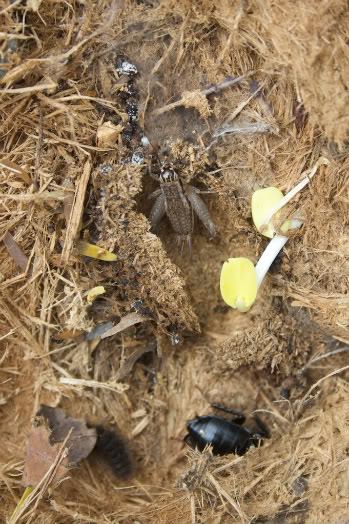 |
| Campos-Arceiz. (c) |
Another interesting idea that the paper promotes, and an idea that converges with some of my own speuculations, is that the intestinal flora that allow digestion of cellulose and lignocellulose has essentially been conserved from dinosaur to cockroach to termite. That is dino dung eating roaches picked up the dino intestinal flora from eating dino dung. These roaches, the Blattulidae, passed on the flora to their descendant the wood roaches (Cryptocercus) and termites. With the extinction of the dinosaurian herbivore megafauna, the Blattulidae bit the dust as well. Wood roaches and termites, not as intrinsically dependent on dino dung as the Blattulidae, carried on to their present state. So, by extension, if you have a problem with termite damage in your building- maybe you can blame dinosaurs.
Now for me this is an endlessly fascinating idea. As you may tell I am very interested in the grey space between things and drawing a seamless narrative from deep time into the present. This idea encapsulates both of those interests of mine. If you came to this blog hoping to hear about phylogenetic arguments, you came to the wrong blog.
On a related note, I have in the past suggested that many dinosaurs took advantage of detrital food chains. In a Mesozoic world full of highly fibrous plants with a slow release of energy it may have proved useful to utilize the external stomach of detritivory. Ankylosaurids I am especially suspicious of- having dubbed them the "mobile compost bins of the Mesozoic". So I am going to leave you with a photo below of a nile crocodile eating elephant dung to consume all the dung beetles within it. It should not be too hard for you to follow my train of thought here.
| Nile croc eating dung for insect prey. Here. |
Pertinencia
Campos-Arceiz, Ahimsa. (2009) Shit Happens (to be Useful)! Use of Elephant Dung as Habitat by Amphibians. Biotropica 41(4): 406-407
Vršanský P, van de Kamp T, Azar D, Prokin A, Vidlička L, et al. (2013) Cockroaches Probably Cleaned Up after Dinosaurs. PLoS ONE 8(12): e80560. doi:10.1371/journal.pone.0080560
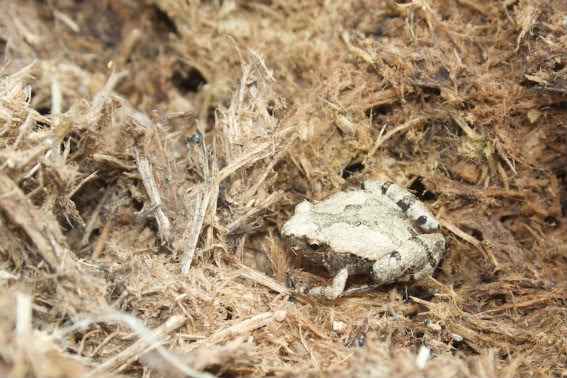 |
| Campos-Arceiz. (c) |
Support me on Patreon.
Like antediluvian salad on facebook.
Watch me on Deviantart @NashD1.Subscribe to my youtube channel Duane Nash.
My other blog southlandbeaver.blogspot.


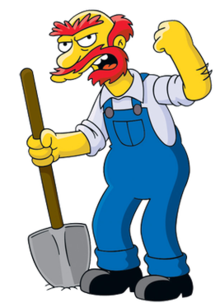
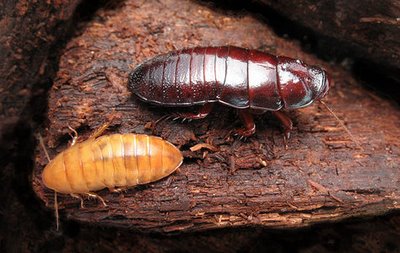
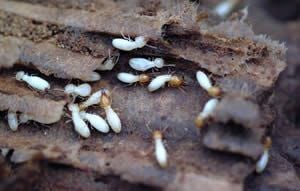
4 comments:
Fascinating post! As an ecologist with an interest in palaeontology this subject interests me too.
Thanks for commenting and compliment Alexander.
Neat post! Since there's evidence of hadrosaurs eating rotting wood, I'd suggest an additional wrinkle. The idea is that, like earthworms, dinosaurs might have had an "external rumen." In the case of earthworms, the soil they grind through is in some ways like the rumen of an animal, where organisms work on earthworm castings, and the results are reingested by the earthworm to derive nutrients.
Here I'd suggest that dinosaurs may have been coprophages, not just to get the insects, but to get the dung post-processed by insects and thereby made more nutritious. Of course, dung is not a "private resource" the way gut contents are, so there may well have been a whole brown ecosystem of decomposers eating both poop and the contents of poop, taking some nutrients and releasing others for subsequent consumers.
Yes "brown ecosystem" I like it!!! Would have been neat to poke into a sauropod patty and see what was living in and off of it.
Post a Comment